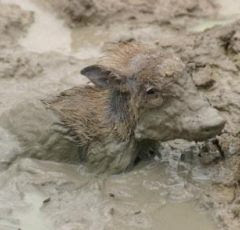 We live along the live along the crumpled southeastern edge of Wrangellia. Almost everyday we walk through a Regional District Park where the granite intrusions rub shoulders with the far older basalts of the Wrangellia Terrane. Wrangellia, like almost all of the rocks that underlie British Columbia, was formed elsewhere and transported here in the distant geological past.
We live along the live along the crumpled southeastern edge of Wrangellia. Almost everyday we walk through a Regional District Park where the granite intrusions rub shoulders with the far older basalts of the Wrangellia Terrane. Wrangellia, like almost all of the rocks that underlie British Columbia, was formed elsewhere and transported here in the distant geological past. The margin of the North American continent has grown westward from the Alberta border by the addition of exotic fragments of the Earth's crust, which geologists call 'terranes'. Wrangellia Terrane originated within what is now the Pacific Ocean and was transported northeasterly on the now mostly subucted Farallon plate to collide with North America about 100 million years ago. The force of this collision crumpled North American rocks as far to the east as the Rocky Mountains.
Small chuncks of the once mammouth Farallon plate are still being suducted by the relentless westward crawl of the North American plate. The Jaun de Fuca plate, off the west coast of fair Wrangellia, is one such chunk. Wrangellia is still slowly compressing/uplifting and will continue to until the last bits of ancient Farallon are subducted many millions of years from now.
Riding west now, along with the rest of North America, here on the edge of Wrangellia won't give me motion sickness, but it can be liberating during those fleeting moments when, by paying attention to Wrangellia's long ride on the Farallon, its suturing onto N. America, and its subsequent change of heading, i catch a glimpse of deep time. How uplifting it is to realize that all the dubious delusions of our 'civilization' will one day amount to no more than a pencil thin line of stainless steel here and there, maybe a blob of bronze, a bit of fossil, or in my case decayed tooth. The birds will sing, the fishes will swim and long will Wrangellia abide despite us.


